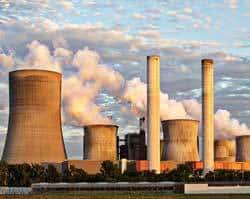Acid Rain: What It Is And Its Impact On The Environment

Many pollutants and greenhouse gases, including carbon dioxide, nitrous oxide, and chlorofluorocarbons, can reach dangerous levels in the atmosphere. A phenomenon called acid rain is often the result.
Acid rain is the umbrella term for any form of precipitation with unusually high acidity levels resulting from sulfur dioxide and nitrogen oxide emissions in the atmosphere. Combined with water, oxygen, and other chemicals, they form sulfuric and nitric acids that bind with water to form acid rain.
If the conditions are favorable, a chemical reaction between these harmful gases and natural elements like water moisture in the air, a type of precipitation occurs that is very harmful to both organic and inorganic matter on the surface.
This phenomenon is called acid rain. The term may sound ominous and invoke images of pure acid falling from the sky and eat away at anything it touches. Although the reality is not nearly as horrific, over time, acid rain still causes significant damage to the environment.
This article examines what acid rain is and how it forms. It then focuses on the important facts you need to know about this phenomenon.
What Is Acid Rain?
The term "acid rain" sounds pretty self-explanatory. It is not that simple, though, and it is more of an encompassing phrase for types of precipitation with a common characteristic. To establish what precisely acid rain is, the name needs to be more clearly defined.
Acid Rain Definition

Acid rain is the umbrella term for any form of precipitation with unusually high acidity levels resulting from sulfur dioxide and nitrogen oxide emissions in the atmosphere. Combined with water, oxygen, and other chemicals, they form sulfuric and nitric acids that bind with water to form acid rain.
Acid rain (also known as acid deposition) describes the different types of acidic elements that get deposited on objects on the planet's surface.
Although the term may sound to refer to a form of "rain," it implies all types of precipitation that contain an unusually high percentage of acidity. It includes forms of precipitation like rainfall, snow, hail, mist, and snow.
It is important to note that acid deposition does not only occur in liquid form. It can be categorized into two types. The one is quite familiar, while the second takes place almost unnoticed while potentially causing more damage. They are:
1) Wet Depositions
Acid rain in the form of wet depositions is the most familiar kind to observers. It includes any type of wet, acidic precipitation, like rain, snow, mist, and hail.
In regions with a high percentage of rainfall, this is the most common type of acidic deposition, as sulfuric and nitric acid binds with water in the atmosphere before falling to the ground.
2) Dry Depositions
Regions with very or low or no rainfall are not exempt from acidic depositions. In countries like Egypt and other arid countries, acid deposition can occur in the absence of rain.
Here, acidic particles and gases attach directly to surfaces on the ground, including artificial structures, vegetation, and water bodies.

For example, the effect of dry acid depositions on the famous pyramids of Giza has become a real and visible concern for archaeological conservationists in the region.
When rainfall does occur, water can wash the acid away from the surface and carry it to lakes, dams, and other bodies of water, raising their level of acidity, which can severely affect aquatic life.
Depending on the absence of rainfall, dry acid deposition can account for as much as 20 - 60 percent of the total amount of acid deposition in a specific region.
To understand acid rain, one needs to understand acidity. Acidity is measured on the pH scale, which ranges from 0 to 17. The most acidic part of the scale is 0, the most alkaline 14, while 7 is the neutral value where an element is neither acidic nor alkaline.
Natural rainwater has a pH level of approximately 5.6 (due to the carbon dioxide present in rainwater that makes it slightly acidic.) Acid rain, however, has a pH level of 4.2 - 4.4 as a result of the presence of sulfuric or nitric acid in rainwater.
Although acid rain can cause long-term damage to the environment and structures, it is not nearly strong enough to cause harm to humans. (For example, vinegar has a pH level of around 2.2, which not only does not harm our skin but can also be safely digested.)
What Causes Acid Rain?
As mentioned in the previous section, rainwater already has a small level of acidity. It is not strong enough to cause any damage to the environment, though. However, when high levels of sulfuric or nitric acid are present in the atmosphere, it can result in acid rain.
Sulfur dioxide & nitrogen oxide do occur naturally. They are produced by volcanic eruptions and weather phenomena like lightning and can also be the result of biological processes. But natural processes play a very small part in sulfur dioxide & nitrogen oxide production.
The vast majority of sulfur dioxide and nitrogen oxide present in the atmosphere is the result of the burning of fossil fuels (coal, natural gas, and oil) by humans.

The burning of coal to produce electricity is the biggest culprit, closely followed by the emissions from automobiles and heavy industries.
These sources release sulfur dioxide (SO2) and nitrogen oxide (NOX) into the atmosphere. Once in the air, SO2 and NOX react with water, various chemicals, and oxygen to form sulfuric and nitric acid.
Both sulfuric and nitric acid combines with water and fall to the surface in the form of wet deposition, or the corrosive gas can attach directly to objects on the ground in the form of dry deposition in arid regions.
Acid rain does only occur in regions where the toxic acids originated from. Global winds can carry it over vast distances where they result in acid rain on a different continent.
For example, late in the 20th Century, most of the acid deposition in Norway originated in the United Kingdom from where winds carried it over 900 km (560 miles), causing acid rain to destroy the trout and salmon population in Norwegian lakes.
Effects Of Acid Rain
It is clear that acid rain poses a significant threat to the environment. The biggest impact is on objects on the ground that are exposed to acid deposition over an extended period.
A wide range of organic and artificial objects get adversely affected by acid rain. They can be categorized into three sections:
- Effect On Bodies Of Water
- Damage To Vegetation
- Damage To Structures
To get a better understanding of how each category is affected by acid rain, one needs to examine each one in closer detail:
1) Effect On Bodies Of Water
Acid rain has an adverse effect on rivers, dams, and lakes. The most significant impact is on standing bodies of water, especially lakes, where acidity from various sources builds up in the water.

Acid buildup in lakes is a result of direct precipitation, which is further accelerated by rivers carrying acidic water into the lakes. A further contribution comes from acid on the surface that gets washed away by rainwater and carried to lakes by overland flow.
This acid buildup has a deadly effect on aquatic life forms, including fish, shellfish, and even insects. It already resulted in the complete elimination of some fish species like the brook trout in some lakes.
(Earlier in this post, we already highlighted the deadly effect of acid rain on Norwegian lakes where trout and salmon were almost completely wiped out from some lakes in the region.)
2) Damage To Vegetation
Acid rain has a severe effect on vegetation, especially tree life, in regions that experience high levels of acid deposition.
Although plant life and crops can also be affected, it is easier to control acidity in agricultural fields by adding fertilizer to replenish nutrients and also use limestone to counter the acidity in the soil.
Trees are affected by the acid content in rainwater in different ways:
The damage can be so severe that acid rain can result in the large-scale dying of trees within a specific region. The Black Triangle on the German border is a region where the forests in the Jizera Mountains experienced widespread tree death due to heavy industrial activity.
3) Damage To Structures
Buildings, statues, and other artificially created structures are all affected by weathering over time. Acid rain, though, can significantly speed up the breakdown of some structures. Certain natural stone structures are also vulnerable to the effects of acid rain.

Some materials are especially vulnerable to acid deposition and can deteriorate at an accelerated pace when subjected to acid rain. These materials include sandstone, limestone, marble, and a variety of metals.
Objects consisting of these materials can suffer severe deterioration or corrosion over time when it is exposed to acid rain. Gravestones and statues are notable examples of objects that can incur extensive damage due to acid deposition.
Acid Rain Facts
The best way to highlight the characteristics and importance of acid rain is to focus on some key facts about this phenomenon, which is also the subject of this article.
Some of the following points were already mentioned earlier in this post, but the following list will serve to highlight the essential facts and add a few new ones to give you a proper overview of what you need to know about acid rain:
This is a summary of some of the key facts about acid rain. There is much more information available about this phenomenon, but this article managed to capture the most relevant information and explanations.
Conclusion
Acid rain sounds scary, and although there almost no short-term danger to both the environment and humans, the long-term effect is quite severe and can harm or even destroy parts of the environment.
Since acid deposition takes such a long time to show damage to objects, it was not that easy to provide adequate protection in time, if possible at all. Fortunately, the cause is now known, and governments placed regulations in place to limit the production of acidic gases.
The aim of this post was to highlight the key facts of acid rain. To draw a complete picture of the phenomenon, though, it was necessary first to define what acid rain is, how it gets formed, and what its effect on the environment and humans are.
Never miss out again when another interesting and helpful article is released and stay updated, while also receiving helpful tips & information by simply following this link .
Until next time, keep your eye on the weather!

